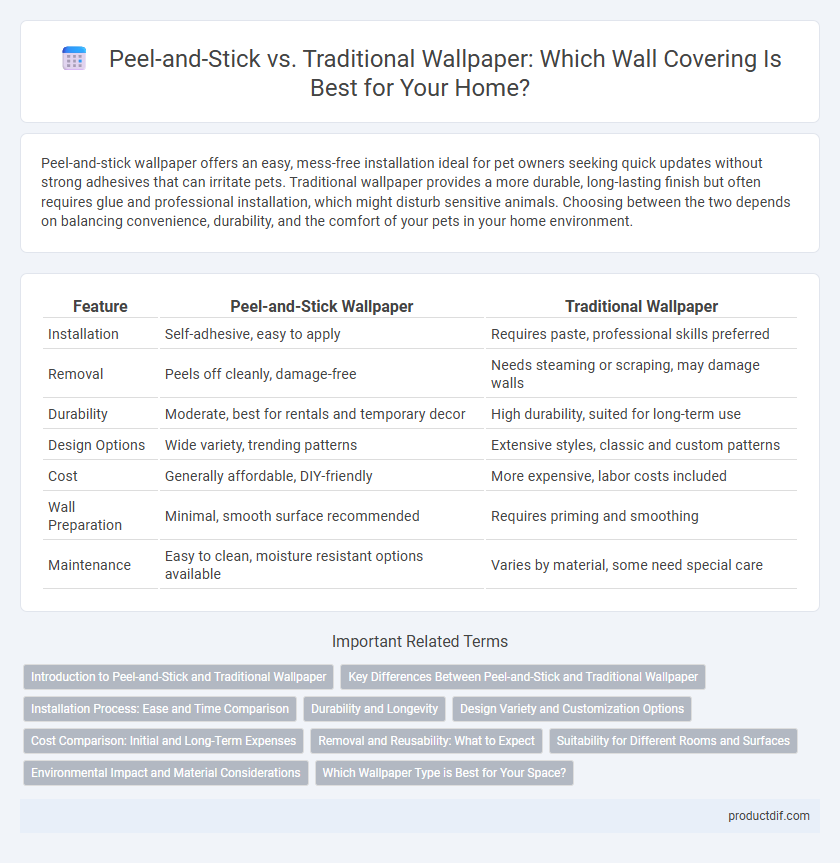Peel-and-stick wallpaper offers an easy, mess-free installation ideal for pet owners seeking quick updates without strong adhesives that can irritate pets. Traditional wallpaper provides a more durable, long-lasting finish but often requires glue and professional installation, which might disturb sensitive animals. Choosing between the two depends on balancing convenience, durability, and the comfort of your pets in your home environment.
Table of Comparison
| Feature | Peel-and-Stick Wallpaper | Traditional Wallpaper |
|---|---|---|
| Installation | Self-adhesive, easy to apply | Requires paste, professional skills preferred |
| Removal | Peels off cleanly, damage-free | Needs steaming or scraping, may damage walls |
| Durability | Moderate, best for rentals and temporary decor | High durability, suited for long-term use |
| Design Options | Wide variety, trending patterns | Extensive styles, classic and custom patterns |
| Cost | Generally affordable, DIY-friendly | More expensive, labor costs included |
| Wall Preparation | Minimal, smooth surface recommended | Requires priming and smoothing |
| Maintenance | Easy to clean, moisture resistant options available | Varies by material, some need special care |
Introduction to Peel-and-Stick and Traditional Wallpaper
Peel-and-stick wallpaper offers a modern alternative to traditional wallpaper with its self-adhesive backing, enabling easy installation and removal without damaging walls. Traditional wallpaper requires paste or adhesive, making application more labor-intensive and often requiring professional skills. Both options provide diverse design choices, but peel-and-stick wallpaper is favored for quick updates and minimal cleanup.
Key Differences Between Peel-and-Stick and Traditional Wallpaper
Peel-and-stick wallpaper features a self-adhesive backing, allowing for easy application and removal without damaging walls, making it ideal for renters and temporary decor. Traditional wallpaper requires paste or adhesive application, offering a more durable and long-lasting finish suitable for permanent installations and intricate patterns. The key differences lie in installation complexity, durability, and removability, with peel-and-stick providing convenience and flexibility, while traditional wallpaper offers depth and texture.
Installation Process: Ease and Time Comparison
Peel-and-stick wallpaper offers a user-friendly installation process requiring no paste, allowing for quick application and easy repositioning within minutes. Traditional wallpaper demands careful paste application, precise alignment, and drying time, often taking several hours or more to complete. The simplicity and speed of peel-and-stick make it ideal for DIY projects and renters seeking minimal mess and effort.
Durability and Longevity
Peel-and-stick wallpaper offers convenient installation but generally has lower durability and longevity compared to traditional wallpaper, which is designed with stronger adhesives and thicker materials. Traditional wallpaper can last up to 15 years or more when properly maintained, while peel-and-stick options typically last 3 to 5 years before peeling or fading occurs. Factors such as humidity, surface preparation, and exposure to sunlight also affect the lifespan of both types, with traditional wallpaper proving more resilient in challenging environments.
Design Variety and Customization Options
Peel-and-stick wallpaper offers a broad range of contemporary patterns and textures, enabling quick customization and easy updates to any room's decor. Traditional wallpaper provides extensive design varieties, including intricate patterns and premium materials like embossed vinyl and silk, allowing for highly detailed and luxurious customization. Both options cater to diverse aesthetic preferences, with peel-and-stick favoring convenience and flexibility, while traditional wallpaper emphasizes long-lasting, elaborate designs.
Cost Comparison: Initial and Long-Term Expenses
Peel-and-stick wallpaper typically has a lower initial cost compared to traditional wallpaper, with prices ranging from $5 to $10 per roll versus $20 to $50 per roll for traditional options. Long-term expenses for traditional wallpaper may increase due to professional installation fees averaging $1 to $3 per square foot, while peel-and-stick can be self-applied, saving labor costs. Maintenance and removal also affect overall cost; peel-and-stick wallpapers are easier and less costly to replace or update without damaging walls, reducing potential repair expenses.
Removal and Reusability: What to Expect
Peel-and-stick wallpaper offers easy removal without damaging walls, making it ideal for renters and temporary decor changes, while traditional wallpaper often requires steaming and scraping, which can damage surfaces. Peel-and-stick options can typically be reused a few times if carefully removed and stored, but traditional wallpaper is generally single-use with no reusability. Expect less cleanup and quicker transitions with peel-and-stick, whereas traditional wallpaper demands more effort for removal and is less flexible for future reapplication.
Suitability for Different Rooms and Surfaces
Peel-and-stick wallpaper offers superior adaptability for various rooms and surfaces due to its easy removal and repositioning, making it ideal for rental spaces, kitchens, and bathrooms where moisture resistance is crucial. Traditional wallpaper provides a durable finish suitable for textured or uneven walls in living rooms and bedrooms but requires professional installation and is less forgiving on high-humidity surfaces. Choosing between peel-and-stick and traditional wallpaper depends on the specific room conditions, wall texture, and long-term maintenance preferences.
Environmental Impact and Material Considerations
Peel-and-stick wallpaper typically uses a removable adhesive that reduces the need for harsh chemical solvents during installation and removal, minimizing environmental pollution. Traditional wallpaper often requires water- or solvent-based pastes that can contain volatile organic compounds (VOCs), contributing to indoor air quality concerns and landfill waste due to non-biodegradable backing materials. Material considerations highlight that peel-and-stick options frequently use vinyl or polyester substrates designed for easy recycling, while traditional wallpaper may include paper or fabric blends with coatings that complicate disposal and sustainability efforts.
Which Wallpaper Type is Best for Your Space?
Peel-and-stick wallpaper offers easy installation and removal, making it ideal for renters or temporary decor changes, while traditional wallpaper provides a more durable and seamless finish suitable for high-traffic areas. Choosing between peel-and-stick and traditional wallpaper depends on factors like room usage, longevity needs, and surface preparation requirements. Peel-and-stick is best for quick updates and less-prepared walls, whereas traditional wallpaper excels in creating a polished, long-lasting aesthetic.
Peel-and-stick vs Traditional Wallpaper Infographic

 productdif.com
productdif.com